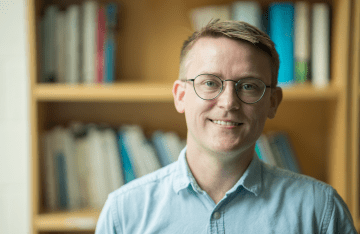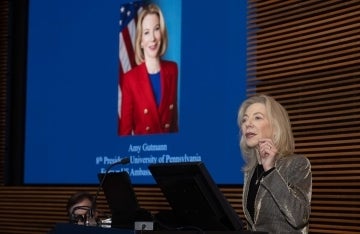Archiving the Creation of a Memorial
In a class taught by Kathleen Hall Jamieson, Annenberg School for Communication doctoral students are documenting the process of creating the Fallen Journalists Memorial in Washington, D.C., interrogating everything from physical site to word choice.

For 14 weeks, first-year doctoral students in Kathleen Hall Jamieson’s Qualitative Ways of Knowing course have worked to better understand the threats journalism faces today, the process of getting the Congressional nod for the new Fallen Journalists Memorial, and the challenges of creating a commemorative monument that conveys all it is intended to represent. (Photo Credit: Eric Sucar)
For weeks leading up to a planned trip to Washington, D.C., on March 25—prime cherry blossom time there—a cohort of Penn graduate students had been watching weather reports with trepidation. Even the morning of, the forecast still called for rain.
But the trip was on, so 11 first-year Annenberg School for Communication (ASC) doctoral students, along with Professor Kathleen Hall Jamieson and ASC IT specialist and ethnographer Kyle Cassidy, set off by train from Philadelphia to spend a largely overcast day visiting the Voice of America building and memorials around the city.
This included time at the site of what will become the Fallen Journalists Memorial (FJM), which eventually aims to both honor journalists who have lost their lives and celebrate the First Amendment’s protection of press freedom. Guided by Barbara Cochran, former journalist and current president of the FJM Foundation, they discussed the importance of the memorial, of situating it in a triangle of land that anchors the National Mall, with the Capitol dome as its backdrop.
Working in pairs, the students spent the afternoon at other memorials on and around the Mall, interviewing visitors about the meanings they derive from the sites. Ph.D. student Calvin Isch, who took his first train trip in the United States that day, focused on the Dwight D. Eisenhower Memorial, designed by famed architect Frank Gehry and dedicated in September 2020, the newest memorial on the Mall. Christiana Dillard had intended to visit the Madison statue in the James Madison Memorial Building—only to learn the building wasn’t open to the public. Devo Probol talked to visitors at both the Vietnam Veterans Memorial and the nearby Einstein Memorial, an experience that provided a jarring contrast of responses.
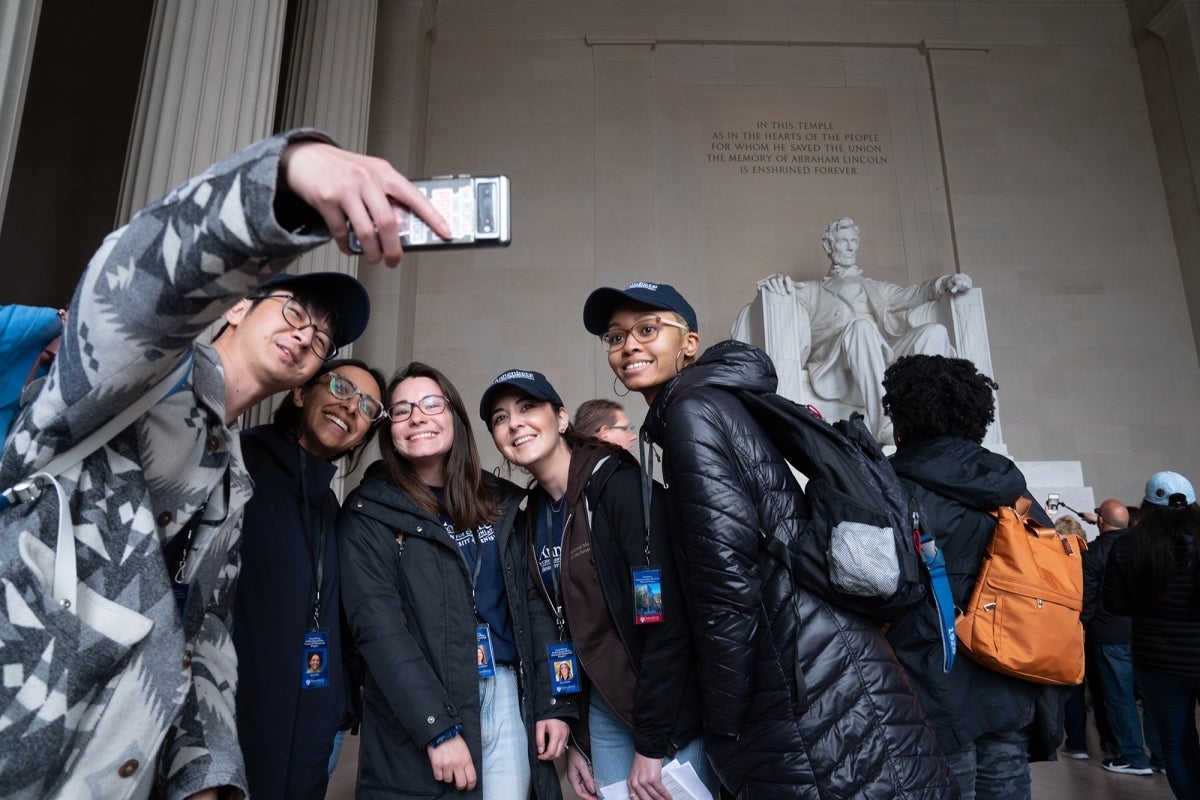
“When we asked people during our interview at the Vietnam memorial what it made them feel, they often described it as somber and solemn, using these deep, intense emotions. People even welled up,” Probol says. “You walk literally across the street and people are so happy, talking about rubbing Einstein’s nose to get some of his intelligence. The two could not be more different in terms of how people memorialize and interact with these objects.”
The trip, part of the Qualitative Ways of Knowing course taught this semester by Jamieson, augments the classroom-based work she and the Annenberg students have done to help document and archive the creation process for the Fallen Journalists Memorial. Beyond seeing the memorials in D.C., they’ve also interviewed many key players—former U.S. Representative David Dreier, journalists like Rick Hutzell, Clarence Page, and Bob Schieffer, architect Paul Goldberger—to better understand the threats journalism faces today, the process of getting the Congressional nod for such a memorial, and the challenges of creating a commemorative work that conveys all it is intended to represent.
Setting the project in motion
On June 28, 2018, Jarrod Ramos walked into the newsroom of The Capital Gazette newspaper in Annapolis, Maryland, and killed five people. At the time, Dreier was chairman of the Tribune Publishing Co., The Capital’s parent organization. “They had died in a newsroom that was part of Tribune Publishing,” Jamieson says. “Honoring their lives and work and the kind of journalism they exemplified has become a mission for him.”
So, on the first anniversary, Dreier launched the nonprofit Fallen Journalists Memorial Foundation, which he runs today with Cochran and Vincent Randazzo. In December 2020, then-President Trump greenlighted the idea, and in December 2022, President Biden approved the preferred site, signing it into law as part of the 2023 Omnibus Appropriations Bill.
“In today’s polarized environment, it’s remarkable that both pieces of legislation not only passed unanimously but were signed into law by presidents of different political parties,” Jamieson says. “For two brief moments in these divisive times, Republicans and Democrats in Congress agreed on the value of a memorial that will both celebrate the importance of freedom of the press and honor the lives and work of journalists who died in service of an informed citizenry.”
Dreier and Jamieson have a long history, dating back to Dreier’s time as chairman of the Rules Committee in the House of Representatives, when, in the ’90s, he and colleagues commissioned Jamieson to write a report for a bipartisan Congressional retreat on comity in the House. Dreier was also a family friend of Walter and Leonore Annenberg, founder and namesake of the Annenberg School for Communication and the Annenberg Public Policy Center (APPC). The Annenberg Foundation, together with the John S. and James L. Knight Foundation, provided $6 million to get the FJM Foundation off the ground. Jamieson and Annenberg dean John L. Jackson, Jr. (who becomes University provost on June 1) are part of the foundation’s advisory board.
Early on, after the first authorization had gone through but no site had yet been selected, Dreier and others approached Jamieson about documenting the process of establishing the memorial. “They asked me to organize an archive chronicling the origins and development of the Fallen Journalists Memorial for the historical record,” Jamieson says. “Such a record would make it possible for future generations to understand not only the context for its creation but also the deliberations that resulted in its ultimate form.”
Jamieson agreed to the project, but felt it was too early to get started. With the second Congressional authorization in the offing and a request from Jackson that she teach the Qualitative Ways of Knowing course this spring, Jamieson saw a great, hands-on opportunity for doctoral students to learn qualitative methods. “This team is writing history, critically analyzing texts, conducting interviews, writing up field notes, mining insights from a focus group, and doing ethnography,” she says. “It’s learning by doing in action.”
A nuanced understanding
On a drizzly evening in March, in a large, open-paneled room on the first floor of the APPC building, the students and Jamieson sat around a long rectangle made up of smaller tables, the center cut out. Having returned from D.C. two days prior, their conversation focused on what they learned from observing visitor interactions with memorials around the city.
They agreed that for the planned site of the future Fallen Journalists Memorial, a tree didn’t, in fact, obscure the important view of the Capitol Building, but that noise from nearby food trucks would complicate the memorial’s ability to serve as a contemplative space. They talked about the ways in which cherry blossoms accentuated one meaning of the Japanese American Memorial to Patriotism During World War II, and about literal and metaphorical reflections in the wall of the Vietnam Veterans Memorial and in the Capitol Reflecting Pool.
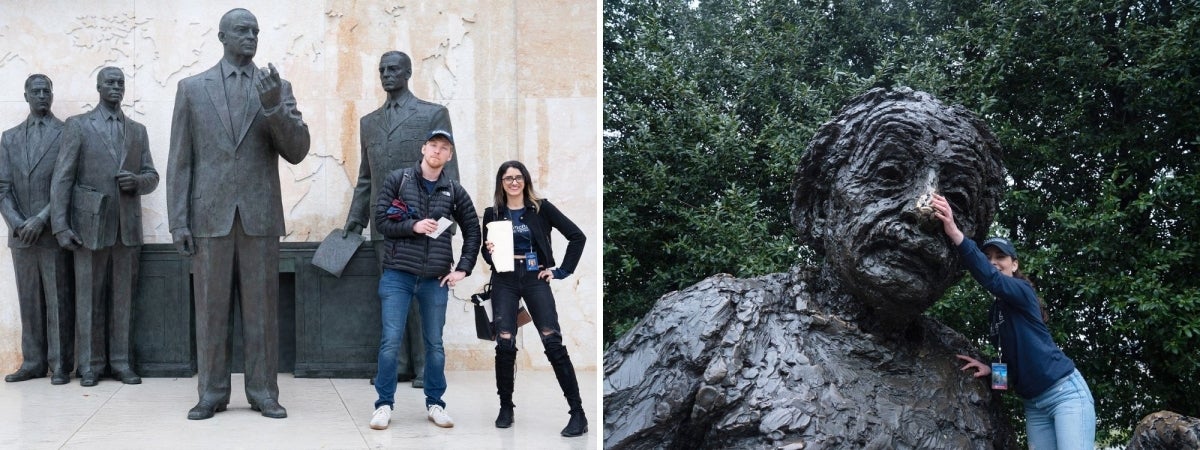
“You’re looking at the past but being brought into the present,” one student said.
“Reflections are good photo ops,” said another.
Dillard mentioned the dissonance she felt at the Lincoln Memorial, stemming from the juxtaposition of selfie-takers in front of the gargantuan Lincoln alongside signs asking for quiet and respect and indicating 24-hour surveillance. She also hadn’t yet processed what, if anything, it meant that they couldn’t physically get in to see the Madison statue.
“I’ve never been somebody big on visiting memorials. I never really thought about them too much,” Dillard explains, a few days later. “Now I definitely am.”
Case in point: She’s lived in Philadelphia for three years but only recently visited the site of the 1985 MOVE bombing that killed 11 people. She says she was curious whether anything at the location today references the event or those who died. “I missed one of the Pennsylvania historical signs—it was across the street—but it felt shocking and disrespectful that there wasn’t more at a place where a literal bomb was dropped on a specific group of people,” she says.
From afar, such nuanced grasp of a memorial or site is rarely possible, Isch adds. “If you just look at pictures, you’ll come to one type of understanding. But when we were at the Eisenhower memorial in person, for example, we noticed there’s no shade coverage. In the summer it will be hot, and people likely won’t spend a lot of time there. Also, the statues are striking, but their material looks odd compared to the background granite.”
The students are thinking critically about monuments in general and the Fallen Journalists Memorial specifically, prompted by Jamieson’s pointed questions: What function do memorials serve? How do different people experience them differently? And what do the choices about what does or doesn’t get memorialized say about the country’s collective reckoning with the past?
‘They’ll see the work we’ve done’
Though the FJM Foundation has found its preferred site, the physical memorial itself is still years away. Jamieson’s class is documenting phase one, which gives the students an opportunity to influence something of permanence.
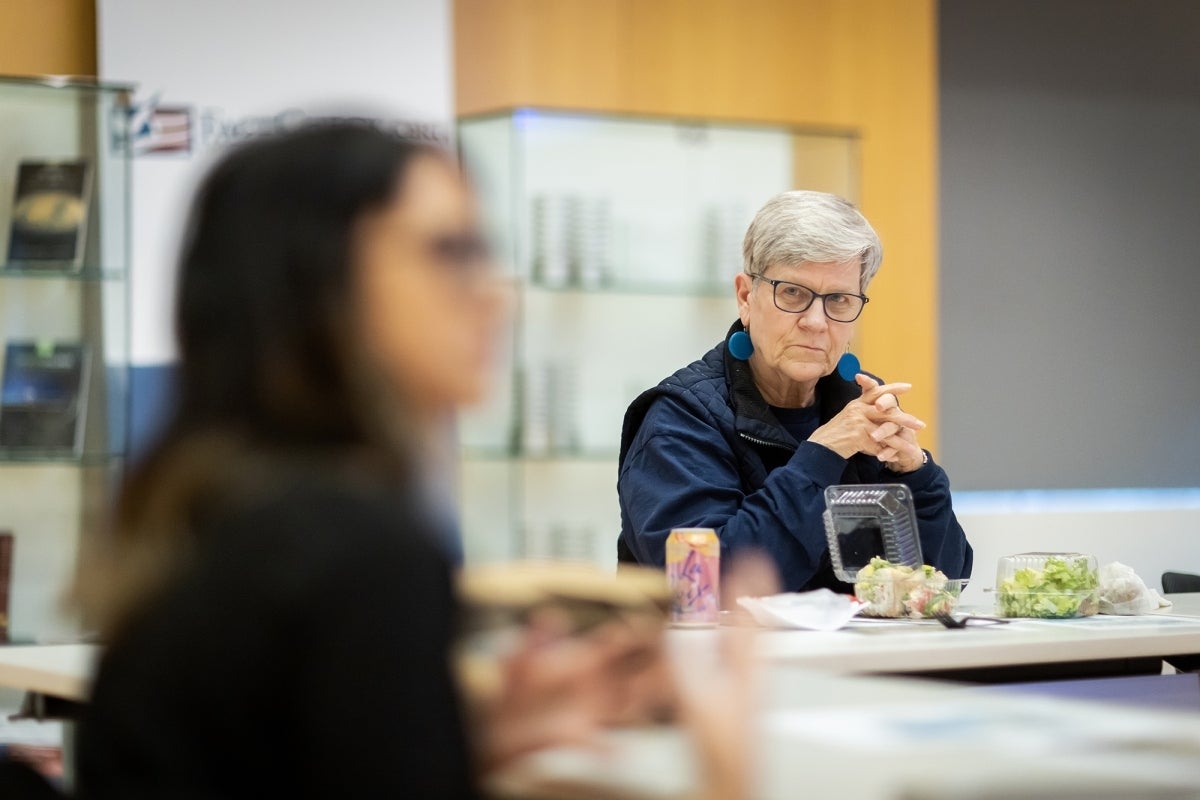
In their roles as archivists, they’re interrogating every aspect, from the physical site to the language choices. What does the word “fallen” evoke? How is “journalist” defined? Research using cellphone data showed that on January 6, 2021, the people attempting to overthrow the election results would’ve gone right past the preferred site of the future memorial—and, as Jamieson notes, probably would have trampled or damaged it. By semester’s end, the students will compile a report detailing that and the many other findings from 14 weeks of work, then they’ll present what they’ve learned to the FJM Foundation and Annenberg faculty and students.
It’s been an intense and eye-opening experience, Isch says, adding that he thinks it’s helped him bridge his mental divide between qualitative and quantitative communication research. Dillard says she’s happy to have had the opportunity to ask hard questions—and that she still has many that will likely go unanswered. “I would love to see an update in three years’ time,” she says. “We’re still in very early stages.”
For her part, Probol thinks about the social impact of the future memorial and gets nostalgic about her own experiences as an eighth grader visiting D.C. from Ohio. “One day when this memorial is built, there will be a researcher interested in how this came to be and they’ll see the work we’ve done,” Probol says. “And I hope young people will look at this memorial and feel a deep sense of purpose. I hope they will understand the loss around journalists who have given their lives in the pursuit of truth. That’s important work and they shouldn’t be lost to the ages.”



